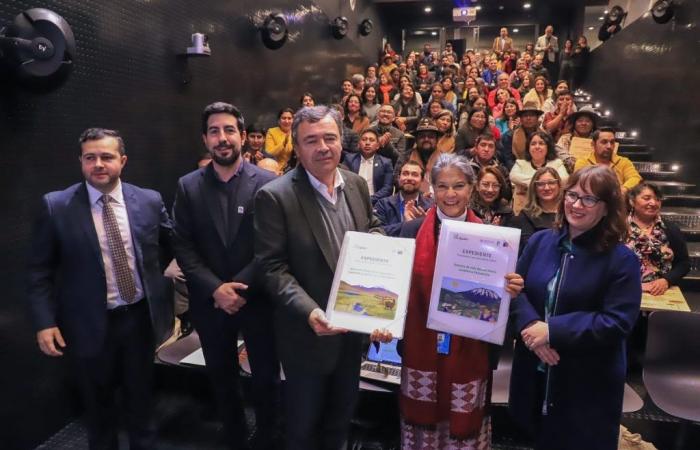
After five years of work between public agricultural institutions, the FAO and the communities of the indigenous Aymara, Quechua, Licanantay, Mapuche Pehuenche and peasant families, the State of Chile, through the Ministry of Agriculture, handed over to the FAO of the files that support the application of these territories for recognition as Important World Agricultural Heritage Systems (GIAHS).
The final intention is to protect agrobiodiversity in Chile through the establishment of a Network of Important Systems of the National Agricultural Heritage (SIPAN) in the AltoAndean Territories and the Northern Precordillera and Cordillera Pehuenche.
The delivery of the files, which marks the beginning of the application process for this global distinction, took place during the inauguration of the Network of Important Systems of the National Agricultural Heritage, headed by the Minister of Agriculture, Esteban Valenzuela and the Representative of FAO in Chile, Eve Crowley, together with a group of women and men who dedicate their lives to agricultural, livestock, and forestry production and who have been protagonists in the protection of forestry and agricultural heritage and ancestral traditional practices.
For the Minister of Agriculture, Esteban Valenzuela, this application marks a milestone in the protection of biocultural heritage in Chile, “after the great work carried out, as a State, we believe it is necessary to institutionalize the SIPAN project, and also form the SIPAN network, where in a “In the near future, other territories that have unique characteristics that make them invaluable at an agricultural, heritage and ancestral level can be identified and integrated, not only for the communities of indigenous peoples but also for the institutions of the State of Chile.”
Globally Important Agricultural Heritage Systems (GIAHS) are defined by the Food and Agriculture Organization of the United Nations, FAO, as extraordinary land-use systems and landscapes rich in biological diversity of global importance that evolve from the co-adaptation of a community with its environment, its needs and aspirations for sustainable development.
This distinction awarded by the FAO seeks to recognize and promote the conservation of sites with cultural, biodiversity, traditional knowledge and landscape characteristics, unique in the world.
Eve Crowley, FAO Representative in Chile, who receives these files from the Minister, emphasizes the relevance of this milestone, “although the administrative path to achieve global recognition of these two territories has just begun, the indigenous peoples have and the peasant communities who, from ancient times until today, have preserved practices and systems for the subsistence of their families and for the planet, such as; the camelid livestock system and the practice of cultivation in fields and terraces in the north, the work of seed guardians, through biodiverse gardens, and the transhumance of animals from summer to winter, in the Pehuenche mountain range. Therefore, the recognition goes to the men and women who have done silent work in protecting this heritage.”
PREVIOUS COUNTRY RECOGNITIONS
In 2011, the Chiloé Archipelago, after several years of work, obtained official GIAHS recognition from the FAO. In this way, the contribution and commitment of the peasant systems of the Chilote community to food security and the conservation of the world’s genetic heritage is highlighted.
In 2012, the recognition was presented to the representatives of the ten communes of the Chiloé Archipelago and to the farmers who are custodians of this agro-cultural heritage, becoming the only GIAHS in Chile to date.
Since 2005, FAO has designated 86 world agricultural heritage systems in 26 countries. Currently in Latin America there are 7 GIAHS sites, Ecuador and Mexico top the list with 2 sites each country. If Chile manages to obtain the designation of these 2 sites that will be nominated, it would take the lead in the region.
PROGRESS OF THE SIPAN PROJECT
During the event, in addition, the progress obtained during the development of the SIPAN project, led by MINAGRI and financed by the Global Environment Facility (GEF) with technical support, was presented. of FAO, as implementing agency, where the following stands out:
-Identification and characterization of 79 traditional practices between both territories, such as the cleaning of canals in the High Andean Territory and the collection of non-timber forest products in the Pehuenche Mountains.
-A digital property diagnosis tool called PrediApp was developed and implemented, selected by FAO as an innovative experience in sustainable agriculture in Latin American and Caribbean countries.
-Installation of nine traditional seed orchards, which have allowed the conservation and reproduction of 34 traditional varieties of corn, beans, quinoas, tomatoes, among others.
-Support for 74 small companies that produce and market products and services derived from agrobiodiversity.
-Identification of 171 non-timber forest products (NTFPs).
-Support for the recognition of camelid farming as intangible heritage of Chile.

